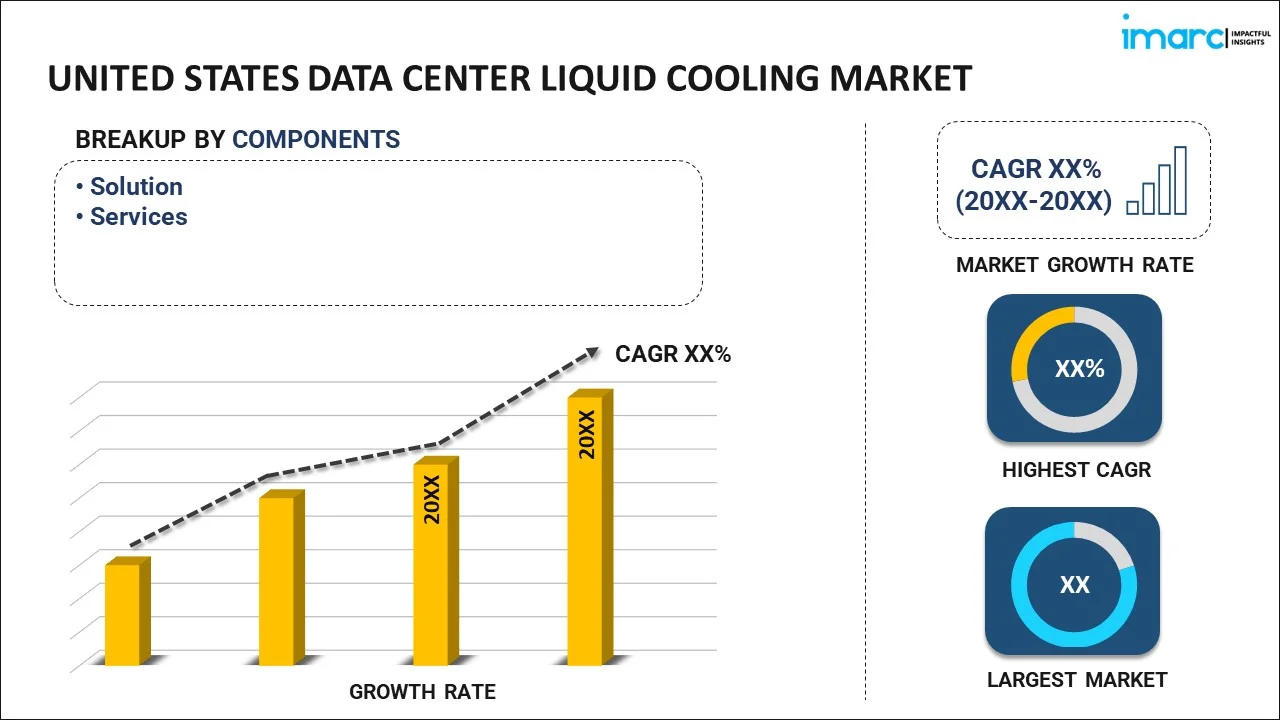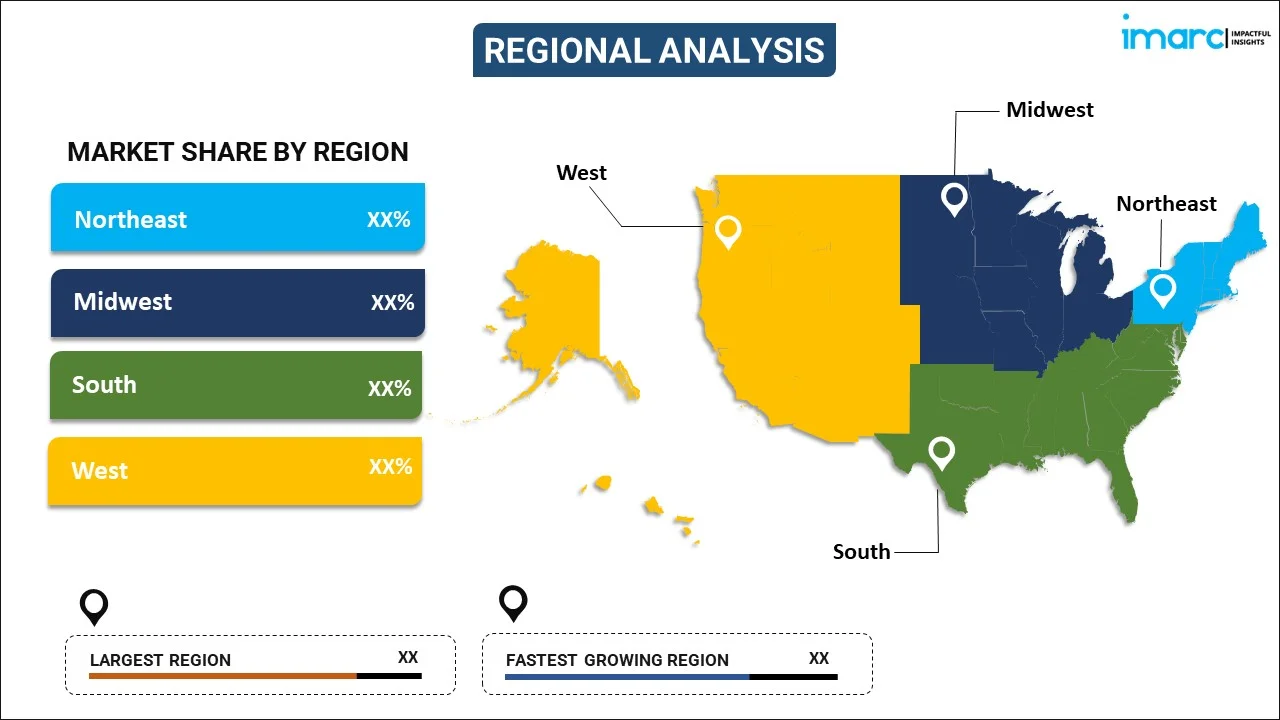
United States Data Center Liquid Cooling Market Report by Component (Solution, Services), Data Center Type (Large Data Centers, Small and Medium-sized Data Centers, Enterprise Data Centers), End Use (Cloud Providers, Colocation Providers, Enterprises, Hyperscale Data Centers), Application (BFSI, IT and Telecom, Media and Entertainment, Healthcare, Government and Defense, Retail, Research and Academic, and Others), and Region 2025-2033
Market Overview:
United States data center liquid cooling market size reached USD 759.4 Million in 2024. Looking forward, IMARC Group expects the market to reach USD 3,153.7 Million by 2033, exhibiting a growth rate (CAGR) of 17.1% during 2025-2033. The increasing demand for data processing and storage, a growing emphasis on energy efficiency and sustainability, the rise of high-performance computing applications, the expansion of edge computing, escalating data traffic, and the need for 24/7 data service availability are some of the major factors stimulating the market growth.
|
Report Attribute
|
Key Statistics
|
|---|---|
|
Base Year
|
2024 |
|
Forecast Years
|
2025-2033
|
|
Historical Years
|
2019-2024
|
| Market Size in 2024 | USD 759.4 Million |
| Market Forecast in 2033 | USD 3,153.7 Million |
| Market Growth Rate (2025-2033) | 17.1% |
Data center liquid cooling is an innovative technology that addresses the increasing demand for efficient cooling solutions in data centers. It involves the use of liquid coolant to dissipate heat generated by servers and other information technology (IT) equipment within a data center environment. It operates on a principle similar to traditional air cooling but employs a liquid medium, typically water or a specialized coolant, to absorb and transport heat away from the components. The advantages of data center liquid cooling are numerous, such as it provides significantly improved thermal efficiency compared to traditional air-cooling methods. Liquid is a much more efficient heat conductor than air, allowing for faster and more effective heat dissipation. Additionally, liquid cooling enables higher server densities, as it can effectively manage the increased heat output of densely packed servers, optimizing the use of space within the data center. Moreover, it contributes to prolonging the lifespan of IT equipment by maintaining lower operating temperatures and reducing the risk of overheating and component failures.
United States Data Center Liquid Cooling Market Trends:
The United States data center liquid cooling market is influenced by several key drivers, such as the increasing demand for data processing and storage capabilities, which has led to the expansion of data center infrastructure across the country. This is further supported by the rapid digitization of businesses, the adoption of cloud computing, and the proliferation of data-intensive applications. In line with this, the escalating concerns over energy efficiency and sustainability are pushing data center operators to explore liquid cooling technologies as a means to reduce power consumption and minimize environmental impact, which is fueling the market growth. Liquid cooling solutions, when implemented effectively, can dissipate heat more efficiently than traditional air-based cooling methods, contributing to lower operational costs and reduced carbon footprints. Furthermore, the rise of high-performance computing (HPC) applications, such as artificial intelligence (AI) and machine learning (ML), has driven the need for enhanced cooling capabilities to manage the heat generated by these powerful systems, which is propelling the market growth in the country.
United States Data Center Liquid Cooling Market Segmentation:
IMARC Group provides an analysis of the key trends in each segment of the market, along with forecasts at the country level for 2025-2033. Our report has categorized the market based on component, data center type, end use, and application.
Component Insights:

- Solution
- Direct Liquid Cooling
- Indirect Liquid Cooling
- Services
- Design and Consulting
- Installation and Deployment
- Support and Maintenance
The report has provided a detailed breakup and analysis of the market based on the component. This includes solution (direct liquid cooling and indirect liquid cooling) and services (design and consulting, installation and deployment, and support and maintenance).
Data Center Type Insights:
- Large Data Centers
- Small and Medium-sized Data Centers
- Enterprise Data Centers
A detailed breakup and analysis of the market based on data center type have also been provided in the report. This includes large data centers, small and medium-sized data centers, and enterprise data centers.
End Use Insights:
- Cloud Providers
- Colocation Providers
- Enterprises
- Hyperscale Data Centers
The report has provided a detailed breakup and analysis of the market based on the end use. This includes cloud providers, colocation providers, enterprises, and hyperscale data centers.
Application Insights:
- BFSI
- IT and Telecom
- Media and Entertainment
- Healthcare
- Government and Defense
- Retail
- Research and Academic
- Others
A detailed breakup and analysis of the market based on applications have also been provided in the report. This includes BFSI, IT and telecom, media and entertainment, healthcare, government and defense, retail, research and academic, and others.
Regional Insights:

- Northeast
- Midwest
- South
- West
The report has also provided a comprehensive analysis of all the major regional markets, which include the Northeast, Midwest, South, and West.
Competitive Landscape:
The market research report has also provided a comprehensive analysis of the competitive landscape in the market. Competitive analysis such as market structure, key player positioning, top winning strategies, competitive dashboard, and company evaluation quadrant has been covered in the report. Also, detailed profiles of all major companies have been provided.
United States Data Center Liquid Cooling Market Report Coverage:
| Report Features | Details |
|---|---|
| Base Year of the Analysis | 2024 |
| Historical Period | 2019-2024 |
| Forecast Period | 2025-2033 |
| Units | Million USD |
| Scope of the Report | Exploration of Historical and Forecast Trends, Industry Catalysts and Challenges, Segment-Wise Historical and Predictive Market Assessment:
|
| Components Covered |
|
| Data Center Types Covered | Large Data Centers, Small and Medium-sized Data Centers, Enterprise Data Centers |
| End Uses Covered | Cloud Providers, Colocation Providers, Enterprises, Hyperscale Data Centers |
| Applications Covered | BFSI, IT and Telecom, Media and Entertainment, Healthcare, Government and Defense, Retail, Research and Academic, Others |
| Regions Covered | Northeast, Midwest, South, West |
| Customization Scope | 10% Free Customization |
| Post-Sale Analyst Support | 10-12 Weeks |
| Delivery Format | PDF and Excel through Email (We can also provide the editable version of the report in PPT/Word format on special request) |
Key Questions Answered in This Report:
- How has the United States data center liquid cooling market performed so far and how will it perform in the coming years?
- What has been the impact of COVID-19 on the United States data center liquid cooling market?
- What is the breakup of the United States data center liquid cooling market on the basis of component?
- What is the breakup of the United States data center liquid cooling market on the basis of data center type?
- What is the breakup of the United States data center liquid cooling market on the basis of end use?
- What is the breakup of the United States data center liquid cooling market on the basis of application?
- What are the various stages in the value chain of the United States data center liquid cooling market?
- What are the key driving factors and challenges in the United States data center liquid cooling?
- What is the structure of the United States data center liquid cooling market and who are the key players?
- What is the degree of competition in the United States data center liquid cooling market?
Key Benefits for Stakeholders:
- IMARC’s industry report offers a comprehensive quantitative analysis of various market segments, historical and current market trends, market forecasts, and dynamics of the United States data center liquid cooling market from 2019-2033.
- The research report provides the latest information on the market drivers, challenges, and opportunities in the United States data center liquid cooling market.
- Porter's five forces analysis assist stakeholders in assessing the impact of new entrants, competitive rivalry, supplier power, buyer power, and the threat of substitution. It helps stakeholders to analyze the level of competition within the United States data center liquid cooling industry and its attractiveness.
- Competitive landscape allows stakeholders to understand their competitive environment and provides an insight into the current positions of key players in the market.
Need more help?
- Speak to our experienced analysts for insights on the current market scenarios.
- Include additional segments and countries to customize the report as per your requirement.
- Gain an unparalleled competitive advantage in your domain by understanding how to utilize the report and positively impacting your operations and revenue.
- For further assistance, please connect with our analysts.
 Inquire Before Buying
Inquire Before Buying
 Speak to an Analyst
Speak to an Analyst
 Request Brochure
Request Brochure
 Request Customization
Request Customization




.webp)




.webp)












